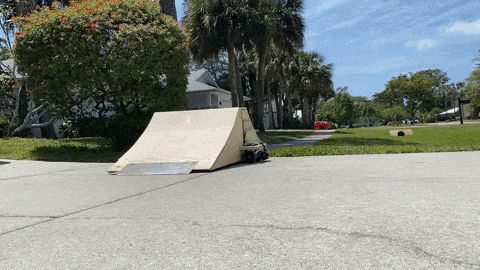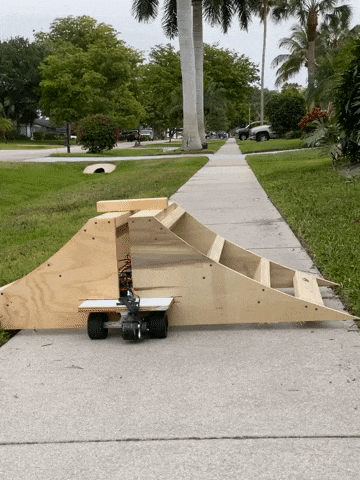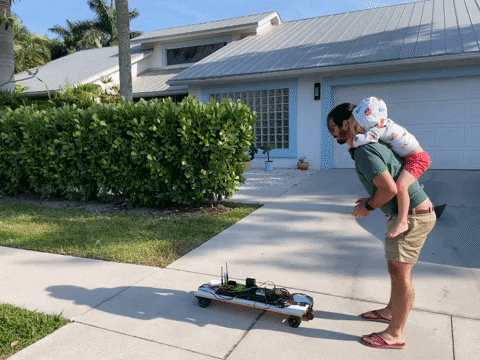
Kirk Kaiser grew up a fan of the video game Paperboy, where players act as cyclists delivering newspapers while encountering various obstacles, like ramps that appear in the middle of the street.
This was the inspiration behind the software developer’s latest project using the NVIDIA Jetson platform for edge AI and robotics — a self-driving skate ramp.
“I wanted the absurdity and fun of Paperboy to be a part of my life,” said Kaiser, an avid skateboarder based in Naples, Fla. “I was boarding one day with my dog Benji running beside me and I was like, ‘What if I had ramps that came with me?’”
He’s now building just that — technology that could lead to a portable, autonomous skate park.
So far, he’s developed an electric platform that can elevate a ramp and make it level with the ground. It’s steerable using a PS4 controller linked via Bluetooth to an NVIDIA Jetson Nano Developer Kit.
Now, he’s collecting data to train AI models that’ll enable the platform to recognize streets and obstacles — and eventually become fully autonomous — with the help of the new NVIDIA Jetson Orin Nano Developer Kit.
It’s a project for when he isn’t engrossed in his work as the head of developer relations at Gitpod, a startup that provides cloud development environments for software makers.

About the Maker
Kaiser learned software engineering at a young age and received a scholarship to a prestigious high school specialized in tech. There, he honed his programming skills before taking time in his early adulthood to see and experience the world in completely different ways.
At 18 years old, he packed a bag and lived for a year in a wildlife refuge in Costa Rica, where he worked on a permaculture farm, growing food and collecting rainwater to drink. Relocating to Vermont, Kaiser then spent a year farming with a Zen Buddhist before hiking 1,000 miles of Appalachian Trail, passing through four states.
Upon leaving the trail, Kirk launched a travel website, got his first software job at a cosmetics company, and worked in R&D for a lighting company before rekindling his passion for software engineering as a way to provide for his family — including his now four-year-old son.
His Inspiration
Before all of this, skateboarding was Kaiser’s greatest love. “I just wanted to skateboard as a kid,” he said. “I wanted to maximize the amount of time I could spend skateboarding.”
He built his own skate parks growing up, which made him familiar with the mechanics of building a wooden ramp — knowledge that came in handy when building the foundation of his latest Jetson-powered project.
And to inspire others to embark on inventive projects with technology, Kaiser authored Make Art With Python, a step-by-step introduction to programming for creative people.
He was spurred to write the book while talking to high school students at a biohacker bootcamp in New York.
“What the high schoolers said blew my mind — they basically thought that software engineering was for overachievers,” he said. “So I wanted to write a book that would convince younger people that programming is fundamentally a platform for creating worlds, and it can be for anyone, which is a really exciting thing.”
His Favorite Jetson Projects
Kaiser kicked off his self-driving skate park project 18 months ago, intending to start with a ramp about the size of a golf cart. The electrical components needed to steer it were prohibitively expensive, however, and getting such a large platform to break along two axes of rotation was incredibly challenging, he said.

Rescaling the project to the size of a skateboard itself, Kaiser bought a welder and a metal brake, learned how to use both tools for the first time, and built a platform that can raise and lower, as well as accept any kind of ramp.

It’s fully steerable along both axes thanks to the edge capabilities of NVIDIA Jetson. And the developer’s now training the platform’s self-driving features using Robot Operating System repositories available through the NVIDIA Isaac platform for accelerated, AI-powered robotics.
“In the machine learning space, NVIDIA is really the only show in town,” he said. “The Jetson platform is the industry standard for edge AI, and its compatibility with other development platforms and the onboard GPU are huge pluses.”
Kaiser dives deeper into the technical aspects of his skate ramp project on his blog.
The developer’s other favorite projects using the NVIDIA Jetson platform include training an AI model for turning lights off and on using a dab and T-pose, as well as creating an AI-powered camera for bird-watching.
“The acceleration of smaller-scale robotics is becoming more accessible to everyone,” Kaiser said, “which is really exciting because I think robotics is so damn cool.”
Go along for the ride by keeping up with Kaiser’s work, and learn more about the NVIDIA Jetson platform.